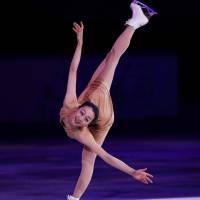The speculation is growing by the minute.
Maybe by the second.
It will be a long weekend for skating fans as they wait to find out what three-time world champion Mao Asada will decide about her future.
Will she return to competition?
Or retire to become solely a show skater?
Recent media reports have stated both scenarios as fact — we know that can't be right — as everybody tries to get the big scoop. So we must play the waiting game for another 48 hours.
Mao is set to have a news conference on Monday afternoon in Tokyo in conjunction with her annual show "The Ice," which she hosts each summer in Nagoya, where she is supposed to give a definitive statement on her plans.
Notes on a Scorecard has contacted multiple sources in the skating community over the past couple of weeks to try and gain some insight on Mao's decision. Every single one of them said the same thing — they didn't know what she was going to do.
Here's hoping that Mao decides to come back. She has too much to offer to skating and her fans to hang it up at 24. In the old days, that would have been a good retirement age for a skater. But not anymore.
Mao is healthy and refreshed after a year off, so many believe she will decide to skate on. But at this point, only she might know for sure.
I'm not a fortune teller, but it would seem to me that if Mao was going to retire, a story like that would be gift-wrapped as an exclusive to her sportscaster sister Mai.
Great athletes like Mao have what we in the sports media business call the "buzz factor." This means they create a stir just by showing up for an event. When Mao walks into an arena she generates electricity — from the fans, fellow skaters and the media.
I have been fortunate to have been around some real superstars in my day, and I can tell you that watching someone like Muhammad Ali or Michael Jordan walk into a room is really something. It doesn't matter how old or jaded you are, star power is star power.
In this country, that is the kind of reception Mao receives.
She continues to be an inspiration to so many, especially young skaters, that it would be very sad to see them deprived of watching her incredible combination of athleticism and elegance on the ice again.
Let's hope it doesn't come to that.
Notes on a Scorecard just finished reading a fantastic book by New York Times sports writer Bill Pennington. "Billy Martin: Baseball's Flawed Genius" is an amazing work and highly recommended.
The tome covers the legend's entire career, from his early days growing up in Berkeley, California, to starring with the New York Yankees in the World Series in the 1950s, to his five stints as manager of the Bronx Bombers. There were many stops in between, and Pennington revisits them all.
I can recall my father telling me stories as a young boy about "Berkeley Billy" and how he watched him play for manager Casey Stengel and the Oakland Oaks in the Pacific Coast League while growing up in the Bay Area before Major League Baseball came to California. This made reading about it so many years later even more compelling.
Martin's managerial genius was often overshadowed by his on-field and off-field antics, but Pennington does an excellent job of putting it all in perspective. When looking at the combination of his playing and managerial careers, it is hard to believe that more than 25 years after his death Martin is not in the Hall of Fame.
A couple of interesting facts that emerged out of the best seller were that on two different occasions Martin was offered the chance to come to Japan and be part of Nippon Professional Baseball.
After being released by the Minnesota Twins during spring training in 1962, the book says Martin turned down a three-year, $100,000 contract to play pro ball here. Notes on a Scorecard tried to find out, without success, which team offered him the big pay day.
Again in 1989, shortly before his death, the book tells about Martin being approached to manage in Japan. I had no luck in establishing which club sought his services then either.
One thing I do know — watching Martin manage in Japan would have truly been a sight to see.
I must say that I found it amusing how the recent title bout between between Floyd Mayweather and Manny Pacquiao was billed as the "Fight of the Century."
If that was the "Fight of the Century," I'm a streetcar.
Is it just me, or has the sporting public become so gullible?
Here you had two fighters, clearly past their primes, clashing five years after they should have. It seemed to smack of how desperate the sport has become more than anything else.
Mayweather is 38. Pacquiao is 36. That sounds like a combination more for a match at the local YMCA, than for a classic championship prize fight.
Just to give some context, let's take a look at a couple of the real epic contests in boxing history.
When Ali and Joe Frazier fought for the world heavyweight title in March of 1971 at Madison Square Garden, Ali was 29. Frazier was 27.
When Sugar Ray Leonard took on Thomas Hearns for the world welterweight title (which I saw in person in Las Vegas in 1981), Leonard was 25. Hearns was 22.
The four legends were all in their physical primes and the bouts reflected that. They were titanic clashes that are still talked about to this day.
What fight fans who saw the Mayweather-Pacquiao fight were treated to was nowhere near the fight of any century — before or after it.



